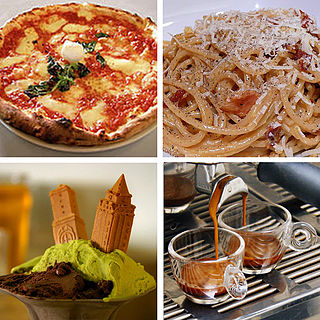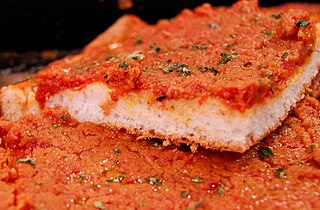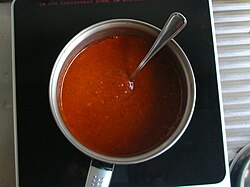
Pizza is an Italian dish typically consisting of a flat base of leavened wheat-based dough topped with tomato, cheese, and other ingredients, baked at a high temperature, traditionally in a wood-fired oven.

Tomato sauce can refer to many different sauces made primarily from tomatoes, usually to be served as part of a dish, rather than as a condiment. Tomato sauces are common for meat and vegetables, but they are perhaps best known as bases for sauces for Mexican salsas and Italian pasta dishes. Tomatoes have a rich flavor, high water content, soft flesh which breaks down easily, and the right composition to thicken into a sauce when stewed, without the need for thickeners such as roux or masa. All of these qualities make them ideal for simple and appealing sauces.

In cooking, a sauce is a liquid, cream, or semi-solid food, served on or used in preparing other foods. Most sauces are not normally consumed by themselves; they add flavor, texture, and visual appeal to a dish. Sauce is a French word probably from the post-classical Latin salsa, derived from the classical salsus 'salted'. Possibly the oldest recorded European sauce is garum, the fish sauce used by the Ancient Romans, while doubanjiang, the Chinese soy bean paste is mentioned in Rites of Zhou 20

Lasagna, also known as lasagne, is a type of pasta, possibly one of the oldest types, made in very wide, flat sheets. The same-named Italian dish is made of stacked layers of lasagna alternating with fillings such as ragù, béchamel sauce, vegetables, cheeses, and seasonings and spices. The dish may be topped with grated cheese, which becomes melted during baking. Typically cooked pasta is assembled with the other ingredients and then baked in an oven. The resulting baked pasta is cut into single-serving square or rectangular portions.
Neapolitan means of or pertaining to Naples, a city in Italy; or to:

Moussaka is an eggplant (aubergine)- or potato-based dish, often including ground meat, which is common in the Balkans and the Middle East, with many local and regional variations.

Ziti or zite are a shape of extruded pasta originating from the Italian regions of Campania and Sicily. They are shaped into long, wide tubes, about 25 cm long, that need to be broken by hand into smaller pieces before cooking. Ziti have similarities to bucatini, but are much thicker.

In Italian cuisine, ragù is a meat sauce that is commonly served with pasta. An Italian gastronomic society, Accademia Italiana della Cucina, documented several ragù recipes. The recipes' common characteristics are the presence of meat and the fact that all are sauces for pasta. The most typical is ragù alla bolognese. Other types are ragù alla napoletana, ragù alla barese, ragù alla veneta, and so on.

New York–style pizza is a pizza made with a characteristically large hand-tossed thin crust, often sold in wide slices to go. The crust is thick and crisp only along its edge, yet soft, thin, and pliable enough beneath its toppings to be folded to eat. Traditional toppings are simply tomato sauce and shredded mozzarella cheese. This was a popular meal among poor Italians due to the ratio of product from the limited produce.

Spaghetti alla puttanesca is a pasta dish invented in Naples in the mid-20th century and made typically with tomatoes, olives, capers, anchovies, garlic, peperoncino, extra virgin olive oil and salt.

Parmigiana, also called parmigiana di melanzane, melanzane alla parmigiana or, in the United States, eggplant parmesan, is an Italian dish made with fried, sliced eggplant layered with cheese and tomato sauce, then baked. The origin of the dish is claimed by the southern regions of Calabria, Campania, Apulia and Sicily.

Neapolitan ragù, known in Italian as ragù alla napoletana or ragù napoletano, is one of the two best known varieties of ragù. It is a speciality of Naples, as its name indicates. The other variety originated in Bologna and is known in Italian as ragù alla bolognese or ragù bolognese. The Neapolitan type is made from two main parts: meat, and tomato sauce to which a few seasonings are added. Two distinctive features are the type of meat and how it is used, as well as the amount of tomato in the sauce. Bolognese versions use very finely chopped meat, while Neapolitan versions use whole meat, taking it from the casserole when cooked and serving it as a second course or with pasta. Preferences for ingredients also differ. In Naples, white wine is replaced by red wine, butter by lard or olive oil, and many basil leaves are used where Bolognese ragù has no herbs. In the Neapolitan recipe, the content may well be enriched by adding raisins, pine nuts, and involtini with different fillings. Milk and cream are not used, and a relative abundance of tomato sauce is preferred, in contrast to Bolognese use of a minimal amount. The tomato season is much longer in more southern Naples than in more northern Bologna. Like the Bolognese, Neapolitan ragù also has quite a wide range of variants, the best known of which is ragù guardaporta.

Italian cuisine is a Mediterranean cuisine consisting of the ingredients, recipes, and cooking techniques developed in Italy since Roman times and later spread around the world together with waves of Italian diaspora. Significant changes occurred with the colonization of the Americas and the introduction of potatoes, tomatoes, capsicums, maize, and sugar beet—the latter introduced in quantity in the 18th century. It is one of the best-known and most appreciated gastronomies worldwide.

Sicilian pizza is a pizza prepared in a manner that originated in Sicily, Italy. Sicilian pizza is also known as sfincione or focaccia with toppings. This type of pizza became a popular dish in western Sicily by the mid-19th century and was the type of pizza usually consumed in Sicily until the 1860s. It eventually reached North America in a slightly altered form, with thicker crust and a rectangular shape.
The history of pizza begins in antiquity, as various ancient cultures produced flatbreads with several toppings. Pizza today is an Italian dish with a flat dough-based base and toppings, with significant Italian roots in History.

Naporitan or Napolitan is a popular Japanese itameshi pasta dish. The dish consists of soft-cooked spaghetti, tomato ketchup, onion, button mushrooms, green peppers, sausage, bacon and optionally Tabasco sauce. Naporitan is claimed to be from Yokohama.

Neapolitan cuisine has ancient historical roots that date back to the Greco-Roman period, which was enriched over the centuries by the influence of the different cultures that controlled Naples and its kingdoms, such as that of Aragon and France.

Marinara sauce is a tomato sauce usually made with tomatoes, garlic, herbs, and onions. Variations include capers, olives, spices, and a dash of wine. Widely used in Italian-American cuisine, it is known as alla marinara in Italy, where it is typically made with tomatoes, basil, olive oil, garlic and oregano, but also sometimes olives, capers, and salted anchovies. It is used for spaghetti and vermicelli, but also with meat or fish.

Antonio Latini (1642–1692) was a steward of Cardinal Antonio Barberini, cardinal-nephew of Pope Urban VIII in Rome and subsequently to Don Stefano Carillo Salcedo, first minister to the Spanish viceroy of Naples. He is also credited to be the one that made the first "official" Ice cream.

Bolognese sauce, known in Italian as ragù alla bolognese or ragù bolognese, is a meat-based sauce in Italian cuisine, typical of the city of Bologna. It is customarily used to dress tagliatelle al ragù and to prepare lasagne alla bolognese.


















